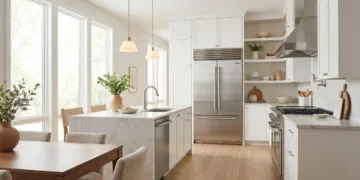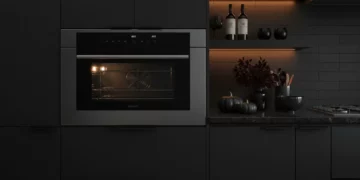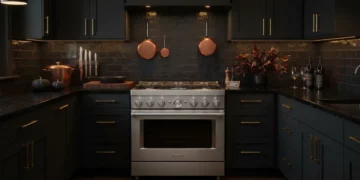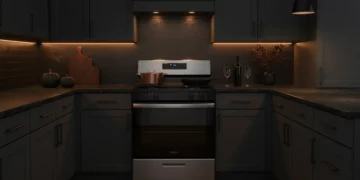Last Tuesday, a young couple hauled their week-old Frigidaire FHPC122AC1 back to our warehouse. “It’s like living in a freezer,” the husband said, showing me photos of condensation dripping down their bedroom walls. They’d bought our biggest portable unit for their 280 sq ft master bedroom, thinking it would cool faster. Instead, the 12,000 BTU unit was short-cycling every eight minutes, never running long enough to pull moisture from the air. We swapped them into an 8,000 BTU window unit (FHWW084TE1) from our closeout section, saving them $110 and solving both their cooling and humidity problems.
This scenario plays out weekly once temperatures hit 100 degrees. Customers grab units too small that grind away without ever cooling properly, or they go oversized thinking bigger means better comfort. After years of matching customers with the right AC units, we’ve learned that proper BTU sizing isn’t just about temperature – it’s about creating comfortable living spaces without wasting money on electricity or equipment.
Understanding BTUs: What Those Numbers Really Mean
BTU stands for British Thermal Unit – essentially measuring how much heat an air conditioner removes per hour. The EPA recommends starting with 20 BTUs per square foot, so a 200 sq ft bedroom needs roughly 4,000 BTUs while a 500 sq ft living room requires 10,000 BTUs. But that’s just the starting point.
Here’s what happens when sizing goes wrong. Last month, a customer ran a 5,000 BTU window unit in his 400 sq ft home office. The unit operated nonstop from noon to midnight, struggling to maintain 78 degrees while adding $85 to his monthly electric bill. He thought buying smaller would save money. Instead, the overworked compressor burned through any savings in about six weeks.
Oversizing creates different problems. Air conditioners cool and dehumidify. When a unit’s too powerful, it reaches the temperature setting in minutes, shutting off before removing moisture. That couple’s 12,000 BTU portable in a 280 sq ft room? Classic oversizing. The room felt cold but clammy – exactly like standing in a walk-in cooler.
Your Real-World BTU Sizing Guide
After helping thousands of customers, we’ve refined the standard calculations for actual living conditions:
Room Size → BTU Range → Our Top Picks
For 150-250 sq ft, you need 5,000-6,000 BTUs. The Frigidaire 5,000 BTU (FHWC054TE1) at $219 handles most bedrooms perfectly. That “Hot Buy” pricing won’t last through summer.
Spaces from 250-350 sq ft require 7,000-8,000 BTUs. Our go-to recommendation: the Frigidaire 8,000 BTU (FHWW084TE1) currently $399.99 with instant savings.
For 350-450 sq ft, look at 9,000-10,000 BTUs. The Frigidaire 10,000 BTU portable (FHPC102AC1) at $459 offers flexibility for renters.
Larger areas 450-550 sq ft need 11,000-12,000 BTUs minimum. The GE 12,000 BTU through-wall (AJEQ12DWJ) just dropped to $699.99 – we’re clearing this inventory before new models arrive.
Critical Adjustments: Remember these aren’t one-size-fits-all calculations. West-facing rooms bake in afternoon sun – add 10-15% more cooling capacity. Shaded rooms can drop 10%. Each person beyond two adds 600 BTUs of body heat. Kitchens need an extra 4,000 BTUs between the stove, dishwasher, and refrigerator constantly running. Ceilings over 8 feet? Add 1,000 BTUs per extra foot.
Small Spaces: Bedrooms and Home Offices
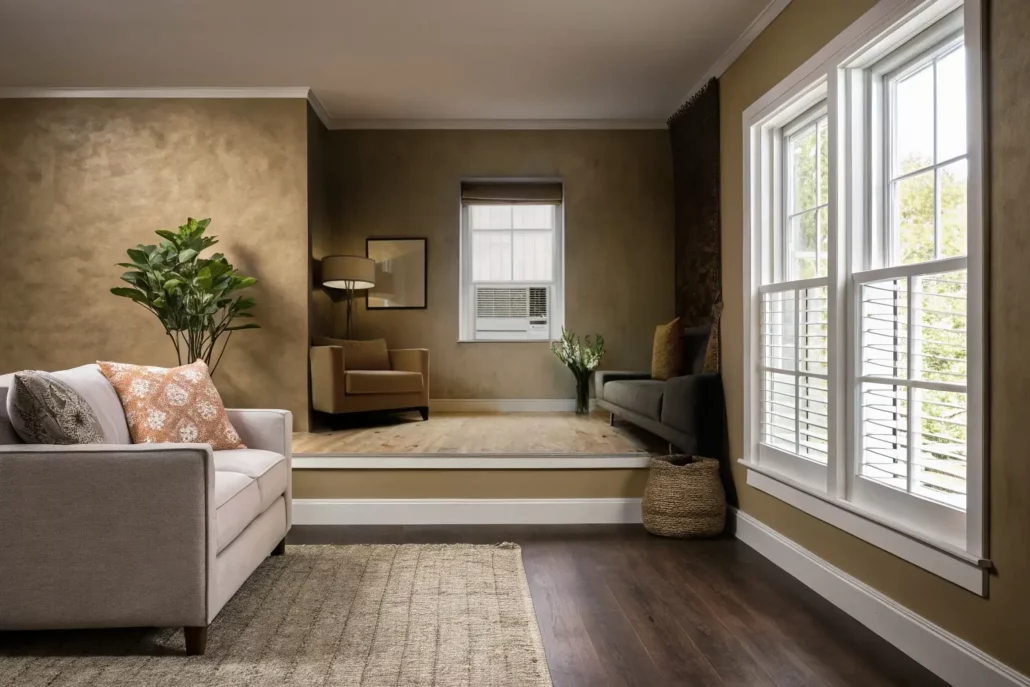
The 5,000 BTU Frigidaire (FHWC054TE1) remains our top seller for good reason. At $219, it cools 150-200 sq ft bedrooms while operating at 51 decibels – quieter than normal conversation. The newer models use improved refrigerants that increase efficiency compared to older units.
Slightly larger rooms or those catching afternoon sun benefit from the 6,000 BTU model (FHWC064TE1) at $259. That extra capacity prevents constant operation during heat waves. Both carry Energy Star certification, which means they’re at least 10% more efficient than non-certified models – typically saving around $20-30 monthly depending on your usage and local electricity rates.
Pro tip from our installation team: Foam weather stripping around window units prevents more cooling loss than any other single upgrade. We stock rolls for $8. Without proper sealing, gaps around the unit equal a tennis ball-sized hole bleeding cold air outside.
Medium Rooms: Living Spaces and Master Bedrooms
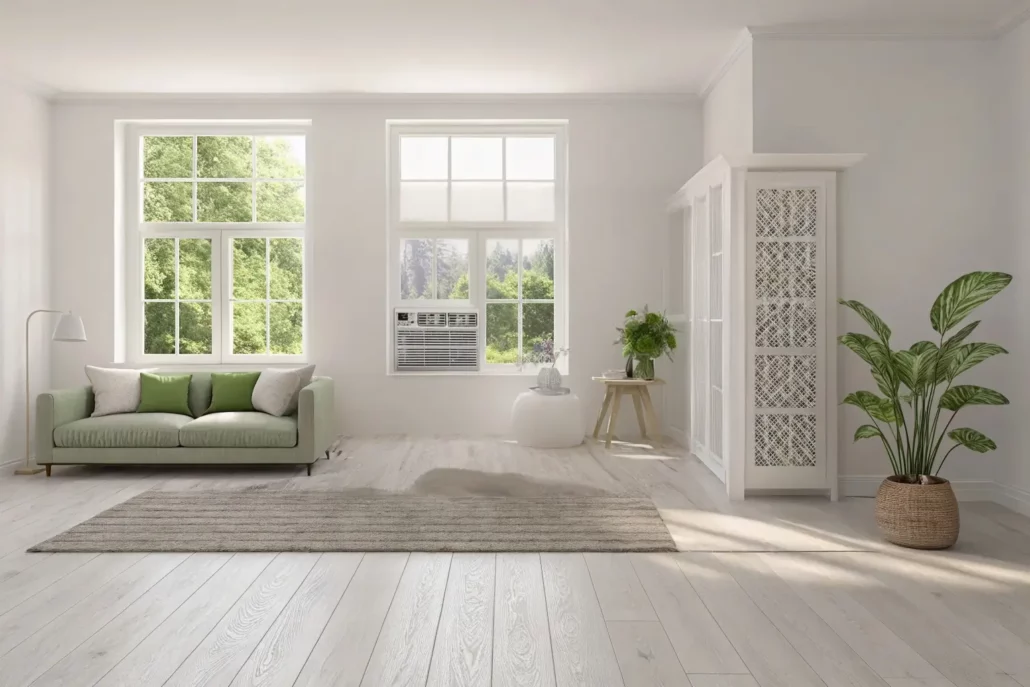
Most living areas fall into the 250-350 sq ft range where 8,000 BTUs provides ideal cooling. The Frigidaire window unit (FHWW084TE1) at $399.99 delivers with three fan speeds and programmable timer. Currently marked $29 off because we overordered expecting last summer’s heat to continue.
Renters constantly ask about portable options since many leases prohibit window installations. Fair warning – portable AC ratings can mislead. The DOE changed testing standards in 2017, and now that “10,000 BTU” portable actually delivers about 6,000 BTUs of cooling under the new SACC (Seasonally Adjusted Cooling Capacity) ratings. The old ASHRAE ratings didn’t account for heat generated by the unit itself or air infiltration. Always look for “DOE” or “SACC” ratings on the yellow EnergyGuide label.
Through-wall units like the GE 8,300 BTU model work for permanent installations. These typically fit standard wall sleeves common in many homes. Last week, we helped a customer slide this exact model into an existing sleeve – perfect fit.
Large Areas: Open Concepts and Finished Basements

Open floor plans combining kitchen, dining, and living spaces often exceed 500 sq ft, challenging single units. The GE 12,000 BTU through-wall (AJEQ12DWJ) now $699.99 handles these areas when properly positioned. That steep $290 discount reflects our need to clear inventory before new models arrive.
For portable flexibility in large rooms, Frigidaire’s 12,000 BTU portable (FHPC122AC1) at $499.99 includes self-evaporating technology. In dry summer conditions below 85% humidity, the unit evaporates condensation internally. During humid spells, you’ll still empty the bucket daily – physics hasn’t changed, despite marketing claims.
Installation reality: Window seal kits for portable units cost $19 and dramatically improve efficiency. Without proper sealing around the exhaust hose, hot air sneaks back through gaps. We’ve measured 15-degree temperature differences between sealed and unsealed installations.
Common Mistakes That Cost Money
The biggest error? Buying multiple small units instead of one properly sized system. A customer recently purchased three 5,000 BTU units for adjacent rooms in an open floor plan. Total damage: $657 plus three installations. A single 12,000 BTU unit at $499 would’ve cooled more effectively with one remote, one filter, and consistent temperatures throughout.
Ignoring sun exposure wastes electricity. Beautiful west-facing windows become afternoon heat collectors. Rooms needing 8,000 BTUs in shade require 9,000-10,000 BTUs with direct sun. We keep a simple chart showing peak sun hours by window direction – it opens eyes every time.
Portable AC confusion frustrates everyone. Pre-2017 models labeled “10,000 BTU” typically deliver 6,000 BTUs by current DOE standards. The testing changed to account for real-world conditions, but consumer expectations didn’t. Always verify actual cooling capacity using the DOE/SACC rating on newer models.
Making the Right Choice
Start with accurate measurements. Length times width equals square footage – simple but often done wrong. Factor in your specific conditions: ceiling height, sun exposure, occupancy, heat sources. Spending 10 minutes measuring prevents returns and exchanges.
Current inventory includes exceptional values. Those GE through-wall units at $699.99? Once they’re gone, they’re gone. The Frigidaire hot buy pricing typically runs two weeks before corporate adjusts.
When choosing between sizes, lean slightly larger. Modern units include eco modes and variable speeds preventing overcooling. An 8,000 BTU unit with multiple fan speeds offers more flexibility than a 6,000 BTU unit running constantly. The $40-60 price difference returns through lower operating stress and genuine comfort.
Real costs matter: Based on average electricity rates and 8 hours daily use, a 5,000 BTU Energy Star unit costs roughly $25-35 monthly to operate. The same usage with a 12,000 BTU unit approaches $60-80. These are estimates – your actual costs depend on local electricity rates, usage patterns, and the unit’s efficiency. Oversizing by just 4,000 BTUs can add $30-45 monthly – money better spent elsewhere.
Federal tax credits offer 30% of the cost (up to $600) for qualifying Energy Star models installed in your primary residence. Factor this into your budget. Professional installation for through-wall units runs $200-300 but protects your warranty. Window units? Most customers handle installation in under an hour with basic tools. Just remember that $8 weather stripping – it’s the difference between efficient cooling and donating money to your utility company.
The bottom line: proper sizing beats horsepower every time. That couple who returned the oversized portable? They’re sleeping comfortably now with their properly sized 8,000 BTU unit, saving money while staying cool. Get the size right first, and everything else falls into place.

